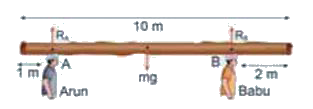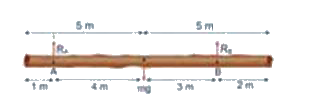Arun and Babu carry a wooden log of mass 28 kg and length 10 m which has almost uniform thickness. They hold it at 1 m and 2 m from the ends respectively. Who will bear more weight of the log? [g = 10 ms−2]
Let us consider the log is in mechanical equilibrium. Hence, the net force and net torque on the log must be zero. The gravitational force acts at the center of mass of the log downwards. It is cancelled by the normal reaction forces RAandRB applied upwards by Arun and Babu at points A and B respectively. These reaction forces are the weights borne by them.
The total weight, W=mg=28×10=280N, has to be borne by them together. The reaction forces are the weights borne by each of them separately. Let us show all the forces acting on the log by drawing a free body diagram of the log.
For translational equilibrium:
The net force acting on the log must be zero.
RA+(−mg)+RB=0
For rotational equilibrium–––––––––––––––––––––––––––––:

Here, the forces RAanRB are taken positive as they act upward. The gravitational force acting downward is taken negative.
RA+RB=mg
For rotational equilibrium–––––––––––––––––––––––––––––:

The net torque acting on the log must be zero. For ease of calculation, we can take the torque caused by all the forces about the point A on the log. The forces are perpendicular to the distances. Hence,
(0RA)+(−4mg)+(7RB)=0
Here, the reaction force RA cannot produce any torque as the reaction forces pass through the point of reference A. The torque of force mg produces a clockwise turn about the point A which is taken negative and torque of force RB causes anticlockwise turn about A which is taken positive.
7RB=4mg
RB=47mg
RB=47×28×10=160N
By substituting for RB we get,
RA=mg−RB
RA=28×10−160=280−160=120N
As RB is greater than RA, it is concluded that Babu bears more weight than Arun. The one closer to center of mass of the log bears more weight.
Topper's Solved these Questions
- MOTION OF SYSTEM OF PARTICLES AND RIGID BODIES BOOK - NCERT TAMILCHAPTER - MOTION OF SYSTEM OF PARTICLES AND RIGID BODIES EXERCISE - EXERCISE (I. MULTI CHOICE QUESTION)
15 Videos
- MOTION OF SYSTEM OF PARTICLES AND RIGID BODIES BOOK - NCERT TAMILCHAPTER - MOTION OF SYSTEM OF PARTICLES AND RIGID BODIES EXERCISE - EXERCISE (V. NUMERICAL PROBLEMS)
6 Videos
- MOTION IN A STRAIGHT LINEBOOK - NCERT TAMILCHAPTER - MOTION IN A STRAIGHT LINEEXERCISE - ADDITIONAL EXERCISES
5 Videos
- NATURE OF PHYSICAL WORLD AND MEASUREMENTBOOK - NCERT TAMILCHAPTER - NATURE OF PHYSICAL WORLD AND MEASUREMENTEXERCISE - EXERCISE (V. Conceptual Questions)
5 Videos
Similar Questions
Knowledge Check
A uniform rope of mass M=0.1kg and length L=10m hangs from the celling. [g=10m/s2] :-
ASpeed of the transverse wave in the rope increases linearly from top to the bottomBSpeed of the transverse wave in the rope decreases linearly from bottom to the topCSpeed of the transverse wave in the rop ramain constant along the length of the ropeDTime taken by the transverse wave to travel the full length of the rope is 2 secA mass of 2 kg tied to a string 1 m length is rotate in a verticle circle with a uniform speed of 4m/s. The tension in the string will be 52 N, when the mass is at (g=10m/s2)
AbottomBhighest pointCmidwayDhorizontal positionA mass of 5 kg is tied to a string of length 1.0 m and is rotated in vertical circle with a uniform speed of 4m/s . The tension in the string will be 130 N when the mass is at (g= 10m/s2)
Ahighest pointBmid wayCbottomDcannot be justified
A mass of 5 kg is tied to a string of length 1.0 m is rotated in vertical circle with a uniform speed of 4m/s . The tension in the string will be 170 N when the mass is at (g=10m/s2)
View SolutionA horizontal wire of length 0.5m carries a current of 5A. If the mass of the wire is 10mg, the minimum magnetic field required to support the weight of the wire is (g=10m/g2)
View SolutionAn object of mass 10 kg falls from rest through a vertical distance of 10 m and acquires a velocity of 10ms−1. The work done by the push of air on the object is (g=10ms−2)
View SolutionA simple pendulum of length 1 m has a wooden bob of mass 1 kg. It is struck by a bullet of mass 10−2 kg moving with a speed of 2×102ms−1. The height to which the bob rises before swinging back is (Take g=10ms−2)
View SolutionA simple pendulum of length 1 m has a wooden bob of mass 1 kg. It is struck by a bullet of mass 10−2 kg moving with a speed of 2×102ms−1. The height to which the bob rises before swinging back is (Take g=10ms−2)
View Solution
